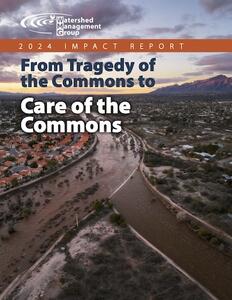Communicating Drought: Collective Action Can Break the Scarcity Cycle
At our staff meeting in mid December, I announced our rainwater tanks were almost dry. We’d been operating on rainwater all year long at our Living Lab, demonstrating what it means to be hydro-local, enjoying rainwater for both indoor and outdoor uses, including drinking rainwater. Now it looked like we could run out of rainwater before year end and have to switch to municipal water.
As we peered into our tanks, and calculated just hundreds of gallons remaining, staff decided to take on the challenge of making our rainwater last until the new year. We brainstormed a list of things we could do to save water in addition to our standard conservation practices. We agreed to wash dishes in a wash bin, use the tippy taps to wash our hands, pause on watering some of our new native plants in the cooler season, and take sponge baths instead of showers after biking into the office.
So did we do it? Yes! Those hundreds of gallons not only lasted through the end of the year, but lasted six more weeks. That meant six more weeks of drinking delicious rainwater!
Since then, I’ve reflected on this scenario, and how it relates to the drought planning work we are embarking on. If staff didn’t know the tanks were low, they would have likely continued business as usual and the tanks would have run dry within a week. But once all of us knew about the shortage details, we collectively devised solutions. Even a group of people already conserving water can conserve more!
The Southwest is in a long-term drought, or mega drought, now going on 30 years. Most years are dryer than normal, and this year we are experiencing a short-term extreme drought, following a few average and wet years. In the Tragedy of the Commons framework, our shared resources, like our aquifers and rivers, will always be overused by the self-interests of individuals. Perhaps this tragedy is perpetuated when communities don’t have information about drought and shortage and don’t have shared conservation strategies.
What if instead we foster a Care of the Commons framework, where we communicate and collaborate, inviting people to steward and care for our precious watersheds? Then, just like at WMG’s Living Lab, many people will make shifts to conserve water for the greater good.
A Care of the Commons framework is one we whole-heartedly embrace at WMG. In this impact report you’ll find many examples of this framework at play, where reciprocity and relationships between nature and peoplecreate a new-found resilience.
Lisa Shipek
Executive Director

